Figure 1 “Weissenhofsiedlung, Arab Village.” Postcard with photomontage of the Weissenhofsiedlung, Stuttgart, ca. 1927. Published by Schwäbischer Kunst-Verlag Hans Boetticher, Stuttgart.Figure 2
“Weissenhofsiedlung, Arab Village.” Postcard with photomontage of the Weissenhofsiedlung, Stuttgart, ca. 1927. Published by Schwäbischer Kunst-Verlag Hans Boetticher, Stuttgart.Figure 2 Ludwig Mies van der Rohe (master plan). Weissenhofsiedlung, Stuttgart, 1927. Postcard.
p. 81
One of the most famous examples of twentieth-century architectural
modernism is the Weissenhofsiedlung near Stuttgart,
a model housing complex designed in 1927 by Mies van der Rohe,
with single-family houses and housing designed by Le Corbusier,
Peter Behrens, Bruno Taut, and a dozen other renowned architects
from the 1920s.1 The Weissenhof’s fame rests, however, on
its notoriety: it became widely known partly thanks to a photomontage
that denounced the white, flat-roof, cube-shape
building ensemble as an “Arab village,” depicted complete with
camels, a lion, and burnoose-clad Bedouins.2 Besides the fact
that this anonymous, racist image used the typically left-wing
or Dada technique of photomontage, what strikes me is that this
cartoonish take on the Weissenhofsiedlung implies an “original,”
presumably also a postcard, taken from the same angle and perspective.3 It turns out the original postcard does exist. Via the defamatory “faking” of a famous urbanist landmark, a visual
medium of modernity comes into view, a medium that has
largely escaped scholarly attention: the architectural postcard.
Ludwig Mies van der Rohe (master plan). Weissenhofsiedlung, Stuttgart, 1927. Postcard.
p. 81
One of the most famous examples of twentieth-century architectural
modernism is the Weissenhofsiedlung near Stuttgart,
a model housing complex designed in 1927 by Mies van der Rohe,
with single-family houses and housing designed by Le Corbusier,
Peter Behrens, Bruno Taut, and a dozen other renowned architects
from the 1920s.1 The Weissenhof’s fame rests, however, on
its notoriety: it became widely known partly thanks to a photomontage
that denounced the white, flat-roof, cube-shape
building ensemble as an “Arab village,” depicted complete with
camels, a lion, and burnoose-clad Bedouins.2 Besides the fact
that this anonymous, racist image used the typically left-wing
or Dada technique of photomontage, what strikes me is that this
cartoonish take on the Weissenhofsiedlung implies an “original,”
presumably also a postcard, taken from the same angle and perspective.3 It turns out the original postcard does exist. Via the defamatory “faking” of a famous urbanist landmark, a visual
medium of modernity comes into view, a medium that has
largely escaped scholarly attention: the architectural postcard.
A few years ago, I was researching the link between film,
architecture, and urbanism in Weimar Germany and was puzzled
that so few of the modernist buildings and housing schemes of
Das Neue Bauen (The New Building), of the Bauhaus, and of the
so-called International Style were depicted on film.4 Why, with
the exception of Hans Richter’s Die neue Wohnung (1930) and
Pierre Chenal’s L’architecture d’aujourd’hui (1930), had virtually
no films, and especially no avant-garde films, recorded or
celebrated this key aspect of modernism?5 What had happened
to the alliance between the Congrès internationaux d’architecture
moderne (CIAM), meeting in La Sarraz in June 1928, and
the Congrès international du cinéma indépendant et moderne
(CICIM), which in 1929 came together at the same location?6
Somewhere, I felt, a link had gone missing, or an inhibiting
factor had been overlooked. I eventually came across statements
by architects themselves—notably Bruno Taut and Mies
van der Rohe—who, while in other respects enthusiasts of
avant-garde (as well as popular) cinema, nonetheless expressed
reluctance to have their buildings filmed.7 In cases where they
did allow a film camera, they tended to use only certain shots
as stills, in order to illustrate their books, articles, or pamphlets.
In one sense, the reason was simple enough: it was a matter of
power and control. Architects felt that once a motion picture
camera was in charge, they could no longer determine the angle p. 82 or point of view from which their building was viewed; hence
the marked preference for still photography or single-frame
layouts. Individual buildings, such as Mies van der Rohe’s Villa
Tugendhat in Brno or his Barcelona Pavilion, were like the
great movie stars who, when “ready for their close-up,” knew
which side of the face or exactly what angle of the nose to present
to the camera.8 Fritz Höger’s Chilehaus in Hamburg, for
instance, is an icon of architectural history precisely because it
can seemingly be viewed from only one angle—the one immortalized
by a postcard. The risk of modern architecture making
bella figura expressly for the camera at the expense of function
and clarity is also the topic of Wilhelm Lotz’s remarkably perspicacious
1929 essay “Architecture Photographs.” Lotz notes,
a danger is evident in current architecture photography—one to which nearly all photographers succumb to varying
degrees, and not only the photographers but also the
architects who have their buildings photographed. . . . For all too often the photographer is anxious to turn his photographs
into good and interesting pictures. To him the
impression the photograph makes as an interesting representation
and an interesting detail is more important than
a clear and objective [sachlich] representation of the object.
Such artistic ambitions on the part of the photographer
are even more evident when there is a noticeable effort to
choose the most interesting possible viewpoint.9
Figure 3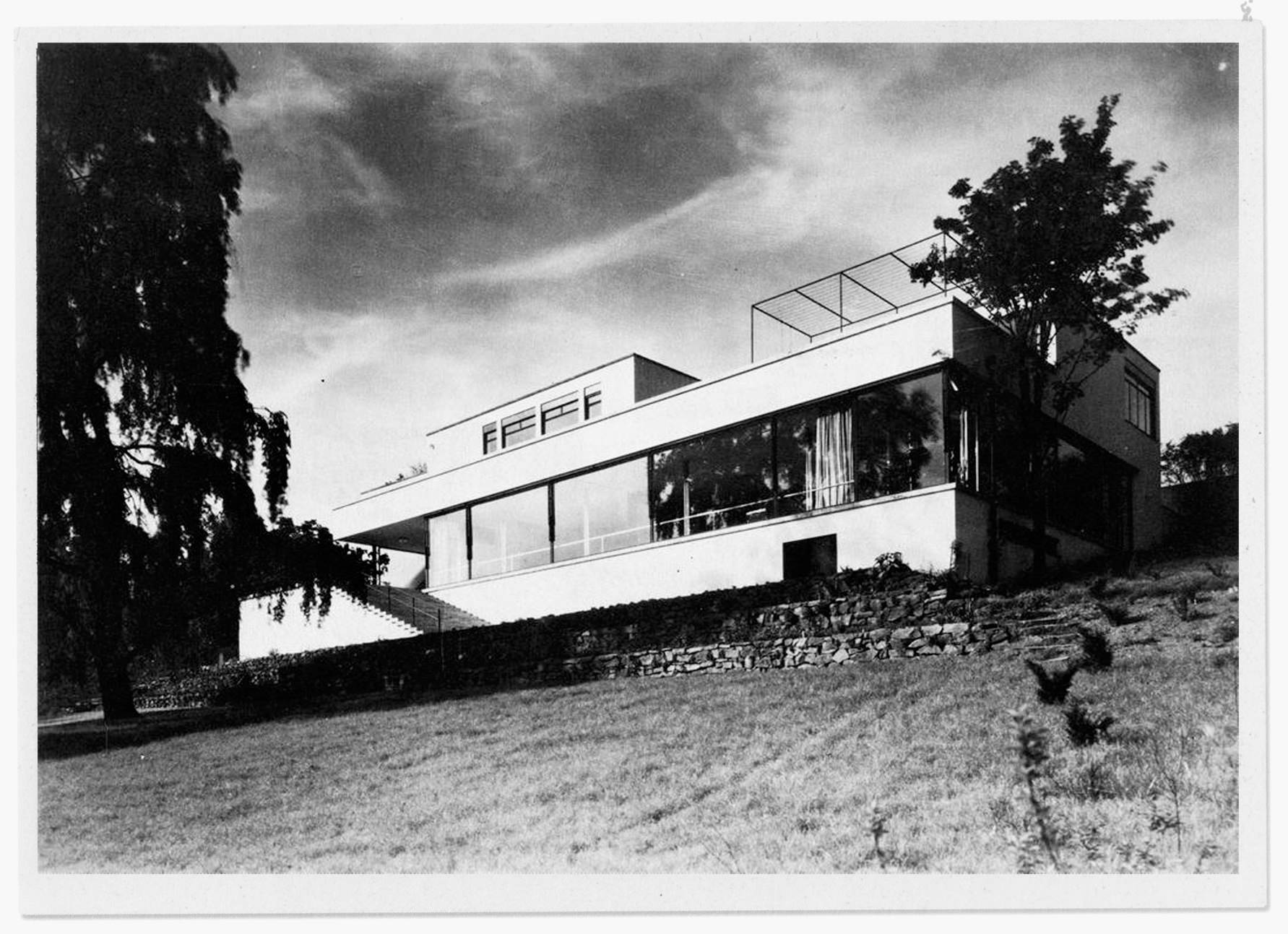 Ludwig Mies van der Rohe. Villa Tugendhat, Brno, 1928–1930. Postcard.Figure 4
Ludwig Mies van der Rohe. Villa Tugendhat, Brno, 1928–1930. Postcard.Figure 4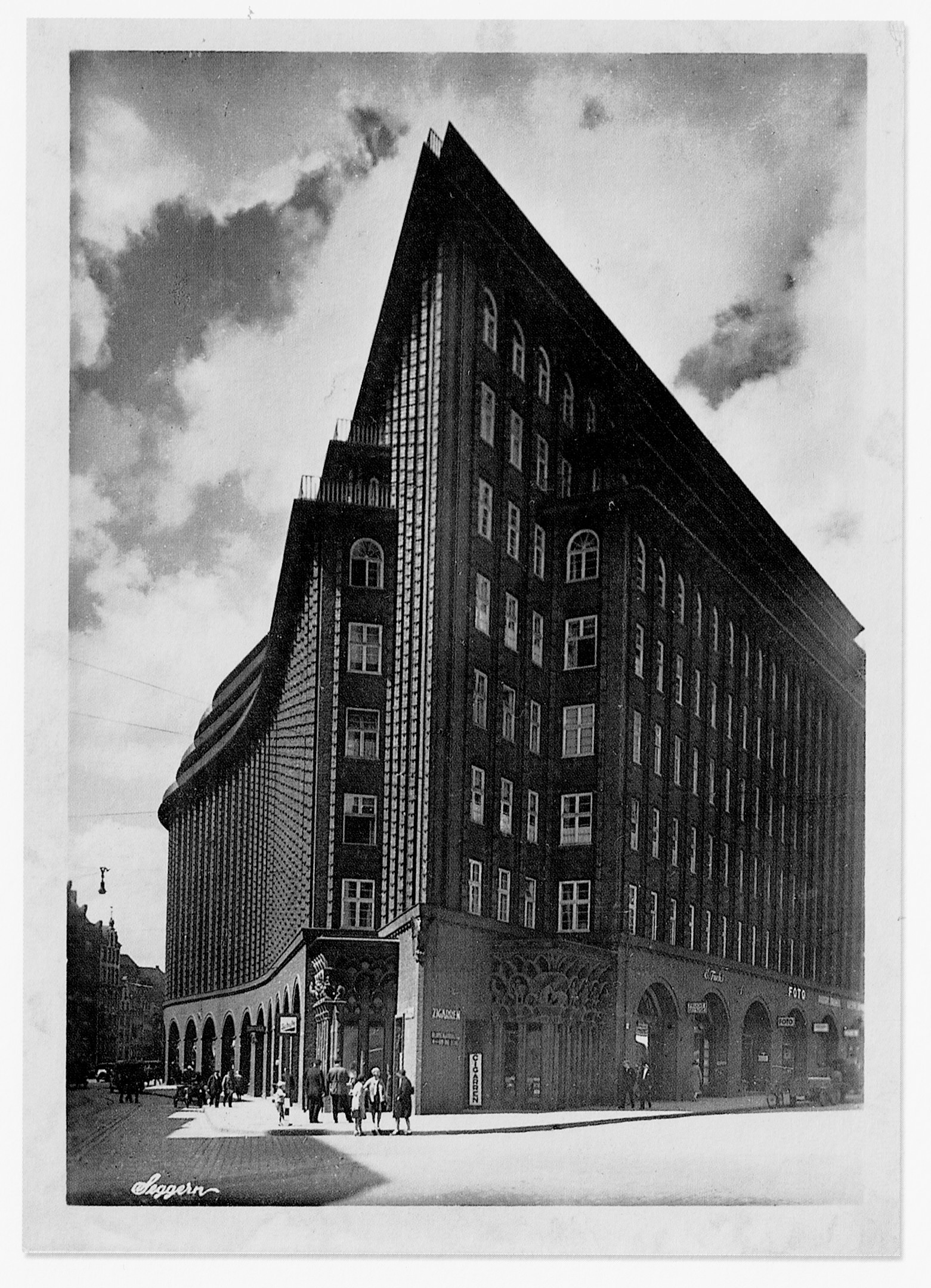 Fritz Höger. Chilehaus, Hamburg, 1924. Postcard with photograph by Georg Toepffer.
This points to a historical continuity across the radical break
posited by modern architecture, since it connects the 1920s
with Adolf von Hildebrand’s 1893 book on the relief, Das
Problem der Form in der bildenden Kunst (The Problem of
Form in Painting and Sculpture). In this text, Hildebrand
insists on the relief as a counterform to sculpture-in-the round,
which requires movement, because only relief sculpture ensures
that beholders are not tempted to displace themselves and take
in the “wrong” view. The same desire to immobilize the spec- p. 83 tator still seems to be at work in the 1920s, suggesting not only
the residual power of perspectival projection even after cubism
and expressionism but hinting at a more general kinetophobia,
which in turn underlines just how crucial—or traumatic—
mobility was to become in modernist architectural discourse.10
Fritz Höger. Chilehaus, Hamburg, 1924. Postcard with photograph by Georg Toepffer.
This points to a historical continuity across the radical break
posited by modern architecture, since it connects the 1920s
with Adolf von Hildebrand’s 1893 book on the relief, Das
Problem der Form in der bildenden Kunst (The Problem of
Form in Painting and Sculpture). In this text, Hildebrand
insists on the relief as a counterform to sculpture-in-the round,
which requires movement, because only relief sculpture ensures
that beholders are not tempted to displace themselves and take
in the “wrong” view. The same desire to immobilize the spec- p. 83 tator still seems to be at work in the 1920s, suggesting not only
the residual power of perspectival projection even after cubism
and expressionism but hinting at a more general kinetophobia,
which in turn underlines just how crucial—or traumatic—
mobility was to become in modernist architectural discourse.10
One is reminded of both Le Corbusier and Sergei Eisenstein
at the Parthenon, extolling the three-quarter or angled view.
The history of that view is so long that it may well connect
twentieth-century architectural postcards to the Greek temples
and other sacred spaces—raising further questions of bodily
displacement and Euclidian geometry, questions tentatively
resolved in the promenade architecturale.11Figure 5 Le Corbusier. Series of sketches made during a visit to the Acropolis, 1911. From Le Corbusier, Voyage d’Orient (1910–1911), carnet 6.
Le Corbusier. Series of sketches made during a visit to the Acropolis, 1911. From Le Corbusier, Voyage d’Orient (1910–1911), carnet 6.
The issue of the view also highlights an unresolved tension
between movement and stasis in modernism: its simultaneous
infatuation with and anxiety about mobility. The Bauhaus and
constructivist wing of the modern movement, with its reliance on straight lines, on geometric forms and the grid—in contrast
to expressionist architecture’s flowing lines—did not always
come to terms with motion and mobility, these key signifiers of
the city, of cinema, and of modern urban life.12 Siegfried
Giedion’s description of Le Corbusier’s row of houses in the
Pessac development is emblematic:
Still photography does not capture them clearly. One
would have to accompany the eye as it moves: only film
can make the new architecture intelligible! But even then,
only in a limited excerpt: does one really think that the
wall on the right, as taut as a movie screen and altogether
deprived of its corporeality, stands there only accidentally,
unrelated to the opening and surface of the brown
elements next to it?13
Crucially, Giedion’s complex reading is often reduced to a blunt
declaration—“Only film can make the new architecture intelligible!”—which is invariably used to bridge the gap between p. 84 architectural and filmic practice rather than to explain the precise
relationship between the two.
A second example is no more resolved: Chenal’s film
L’Architecture d’aujourd’hui (1930) about two of Le Corbusier’s
villas, the Villa Garches and the Villa Savoye in Poissy. The
editing—combining moments of Russian montage with Germanstyle
continuity editing and expansive, unchained (entfesselte)
camera movements—creates a carefully choreographed way of
experiencing the building with one’s body, but here led and
controlled by the architect himself. The film opens with the
architect arriving in his trademark car—the Delage Grand
Esprit—then rapidly traversing the entrance, before leading
Chenal’s camera on a guided tour through the rooms and on to
the balcony.14 But rather than continue to advance cinematographic
editing techniques, Le Corbusier adopted the emblem of movement for static representation: In many photographs of
his buildings, the foreground is occupied by a car.15Figure 6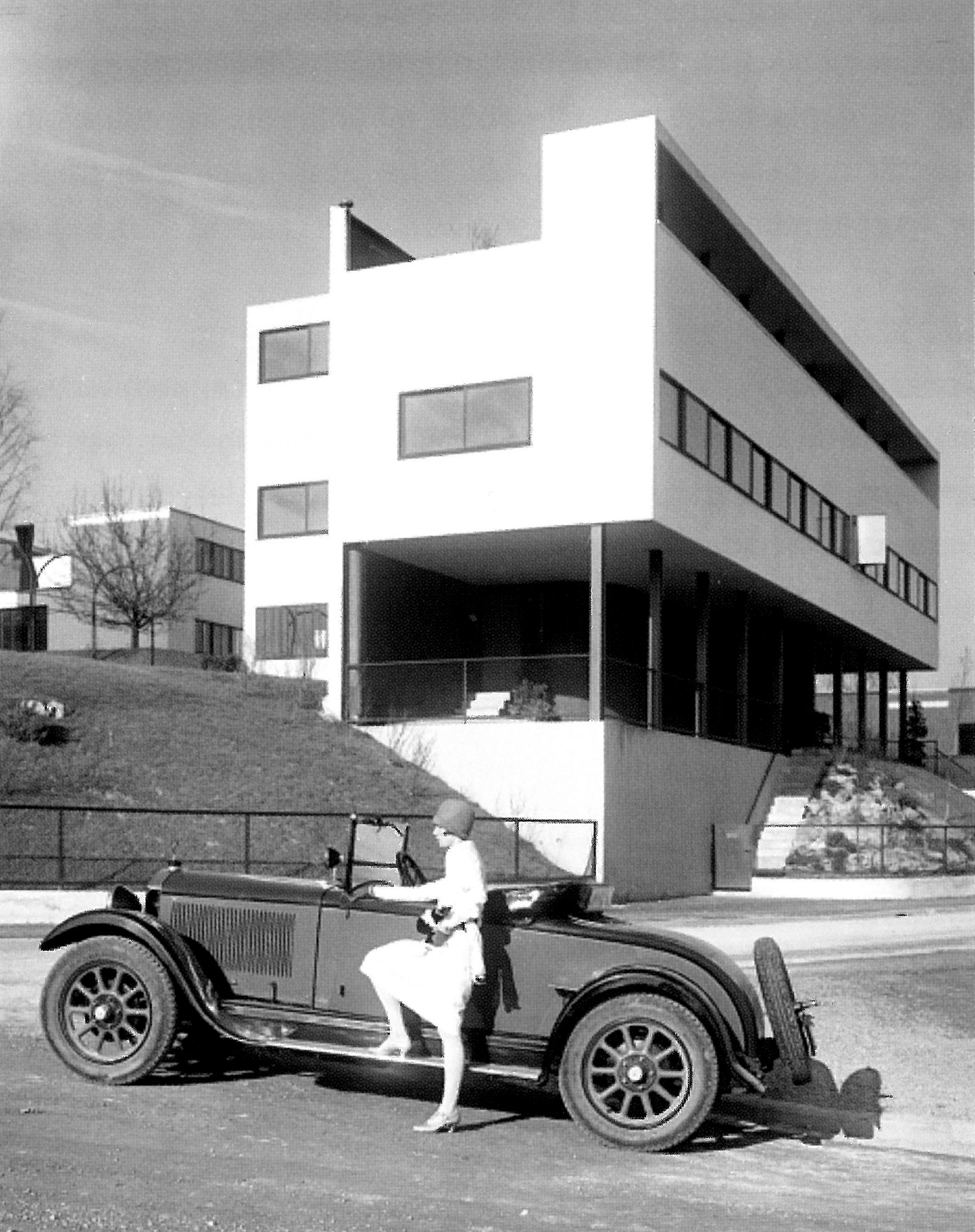 Le Corbusier. Weissenhofsiedlung, Stuttgart, 1927. With a Mercedes parked in front.
Le Corbusier. Weissenhofsiedlung, Stuttgart, 1927. With a Mercedes parked in front.
Architecture and film meet more directly in the modernist
dispute over the “correct” form of the representation of architecture
in the moving and the still image. Almost since the
beginning of cinema, there has been a lively debate as to whether
the moving image is friend or enemy of the architect when it
comes to visually representing his or her buildings. Here the discussion
of two-dimensional reproduction of three-dimensional
space is revived but extended to include nonperspectival forms
of representation, favoring a many-sided and multilayered
perception of an object, as in cubism and expressionism.
Among the architects, Taut took up the discussion in 1913 in an
essay in Herwarth Walden’s Der Sturm, where he directly tackles
the relationship between architecture and modern painting.
Mentioning Fernand Léger, Franz Marc, Robert Delaunay,
Heinrich Campendonk, Alexander Archipenko, and Wassily p. 85 Kandinsky, he notes, “architecture a priori contains within itself
the presupposition that the new painting has created: freedom
from perspective and from the narrowness of the individual
point of view. The buildings of the classic architectural epochs
were invented without perspective, while perspective created
only notorious theater-prop architecture [Kulissenschöpfungen].”16
Taut’s reflections are echoed by Lotz when the latter cites
two examples of photographers offering “an approximation of
filmic representation” by creating a series of consecutive views.
In the case of one house designed by Taut,
[the photographer] advanced toward it incrementally
from the countryside so that one perceives how it becomes
more and more like a cube as one approaches it from a
distance. In the second example, the photographer circled
the house with his camera; by surveying the five ensuing
photographs, one gains a sense of its corporeal physicality
[Körperlichkeit]. For the representation of architectural
objects, similar strips of images [Bildstreifen] may productively
supplement larger pictures, which better show
details.17
Confirming my earlier point about architects preferring
strips of stills to moving images (in order to create the bodily
sensation of movement, rather than expose their buildings to
mechanical movement itself), Lotz also anticipates more-recent
discussions about “new visuality” and “embodiment” and
reflects the neoexpressionist discourse of the “architectural
uncanny.”18 While these reappraisals of perspective, space,
and movement enrich the debate over the affinity of modern
architecture and cinema, they rarely take account of irritants,
complications, and lacunae—precisely what allowed the architectural
postcard to briefly emerge as a mass medium of modern
architecture.
At issue are less the inherently “cinematic” qualities of the
new architecture, or even the architects’ possible discomfort
with the moving image, and more the question of why the
modern movement—in all other respects made up of men who
were masters at self-promotion—passed up an immensely popular
medium such as the cinema to advertise their aims and
achievements. My focus is on this gap between “control” and
“access,” which I see as partly addressed (and filled) by the
architectural postcard. For with the postcard, architects could
have it both ways. Popular and with a potentially wide circulation,
it gave architects a medium of motion and mobility while
not obliging them to relinquish control over how their buildings
were seen.
The modern postcard goes back to 1861 in the United States,
to 1869 in Austria, and 1870 in Germany, when the single printed
piece of card with specified dimensions was licensed by the
(German) post office for private use.19 A by-product of the military
(its trial run was as field post in the Franco-Prussian War),
it was cheaper than a letter and permitted messages to circulate p. 86 more quickly and more efficiently, thus gaining rapid popularity.20 But the postcard also opened up a new communication
space between the private (breaking the much-prized confidentiality
principle of the letter) and the public (the content of
the message was now as accessible as the address).21 The
ambivalence of public and private can be extended to a similar
ambivalence concerning sender and addressee. Postcards soon
became kitschy, frivolous, “naughty,” and often enough pornographic:
ways of teasing prying eyes, embarrassing the addressee,
and daring the censor.22 The pictorial riddle, the rebus picture,
and the photomontage were favored visual modes and motifs.
Thus, precisely because of the public nature of an essentially
private communication, the message on a postcard has always
had a particular rhetorical thrust, being as much a metamessage
as a message: boast, boost, and self-advertising are
never far, especially when the holiday postcard is sent from
fabulous destinations and addressed to those unlucky ones
who had to stay home.Figure 7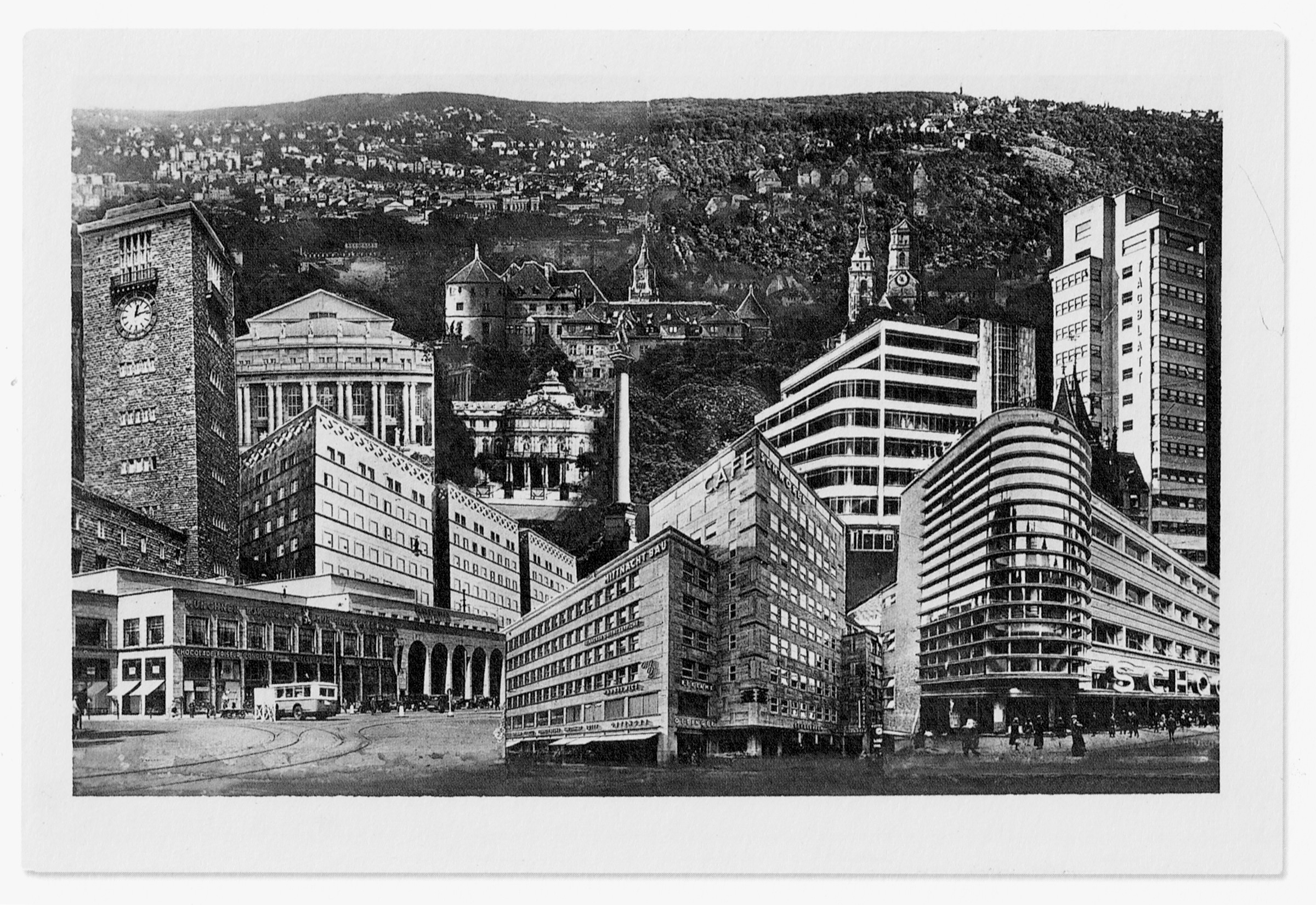 Unknown artist. Postcard with photomontage of buildings, Stuttgart, ca. 1931.
Unknown artist. Postcard with photomontage of buildings, Stuttgart, ca. 1931.
A similar principle obtains in the architectural postcard. But rather than showing a church, a local market, or the hotel, on
which senders figuratively inscribe their own presence in order
to gleefully or regretfully underline the addressee’s absence
(“Wish you were here”), the architectural postcard obeys a
symmetrical but inverted semiotic rule: the general absence of
people makes the building into the dramatis persona, while its
sculptural aspects (the angled or profile view) and monu -
mental prominence (isolating it as much as possible from the
surroundings) invites curiosity also by invoking the invisible
presence of the building’s creator. The architectural postcard,
more than just recording a visit by a tourist to an architectural
site, functions as a calling card identifying the architect
as author.
The sculptural aspect—achieved at the price of voiding the
site of the human user—is in some ways a provocation but also
what most fascinates the eye. These postcards invite collection
as much as sending. A fetishism of possession creeps into one’s
gaze, as Jean-Luc Godard satirizes in Les carabiniers (1963).
For his two protagonists, postcards are the spoils of war, and p. 87 to own the picture is to possess what it represents. The image
materializes the object in several respects: it makes it circulate
at the same time it turns it into a commodity, but a
commodity not so much bought and sold as endowing its
decontextualized monumental presence with the potency of
a fetish or totem. Figure 8 Jean-Luc Godard, dir. Les carabiniers, 1963. Frame enlargement.
Jean-Luc Godard, dir. Les carabiniers, 1963. Frame enlargement.
Architectural postcards were mass-produced to be handed
out at trade fairs, sold on-site, or given away by the architect.23
Pioneers include Erich Mendelsohn and his clients, the
Schocken Brothers. For the Schocken department-store chain
in Germany, Mendelsohn designed distinctive buildings whose
elegant curves and white bands of masonry alternating with
broad expanses of glass virtually defined modern shopping. By
incorporating the lettering into the façade and making sure the
building looked as spectacular at night, when lit with neon
lights, as it did in daytime when reflecting the sun, Mendelsohn
underscored the tendency of architecture to become a visual
medium in its own right, over and above serving as built space.
Architecture now functioned in the multimedia context of photography, advertising, shopping, and urban living.24 The
Schocken buildings, made famous through postcards (which
were on sale and on display at the checkout counters in the
stores), were among the first conceptual forays into an allencompassing
corporate design (after Peter Behrens and his
AEG factories), in which the thrusting yet modulated outlines
reproduced on the postcards were the key element. Architecture
was at once trademark and advertisement: the logo was the
building and the building the logo.
Here, then, is a popular, ephemeral medium (the postcard),
serving another, more enduring medium (modern architecture),
as both support and vehicle, creating an alliance but not
disavowing their potentially antagonistic relation to each other.
One of the first successful blends of the avant-garde and popular
culture, the architectural postcard perhaps did so well
in the late 1920s because several of the technical media—photography, design, architecture, typography, printing, and publishing—had by then begun to discover their mutual interdependence.
Yet this interdependence conspicuously did not p. 88 involve the cinema as either popular or avant-garde medium.
Modernist design was shaping the cinema in the 1920s in
outward appearance as well as inner form. The Berlin movie
theaters built by Mendelsohn and Taut’s (unrealized) cinemas
are architecture’s tribute to the new experience of lived time
and imaginary space that was the movies.25 In turn, the films
themselves repaid the compliment: Robert Wiene’s The Cabinet
of Dr. Caligari (1920); Hans Poelzig’s sets for Paul Wegener’s
The Golem (1920); Marcel L’Herbier’s L’inhumaine (1924, with
sets by Robert Mallet-Stevens
and Ferdinand Léger); and
Fritz Lang’s Metropolis (1927)
are among the usual suspects
cited to prove the point.26 Figure 9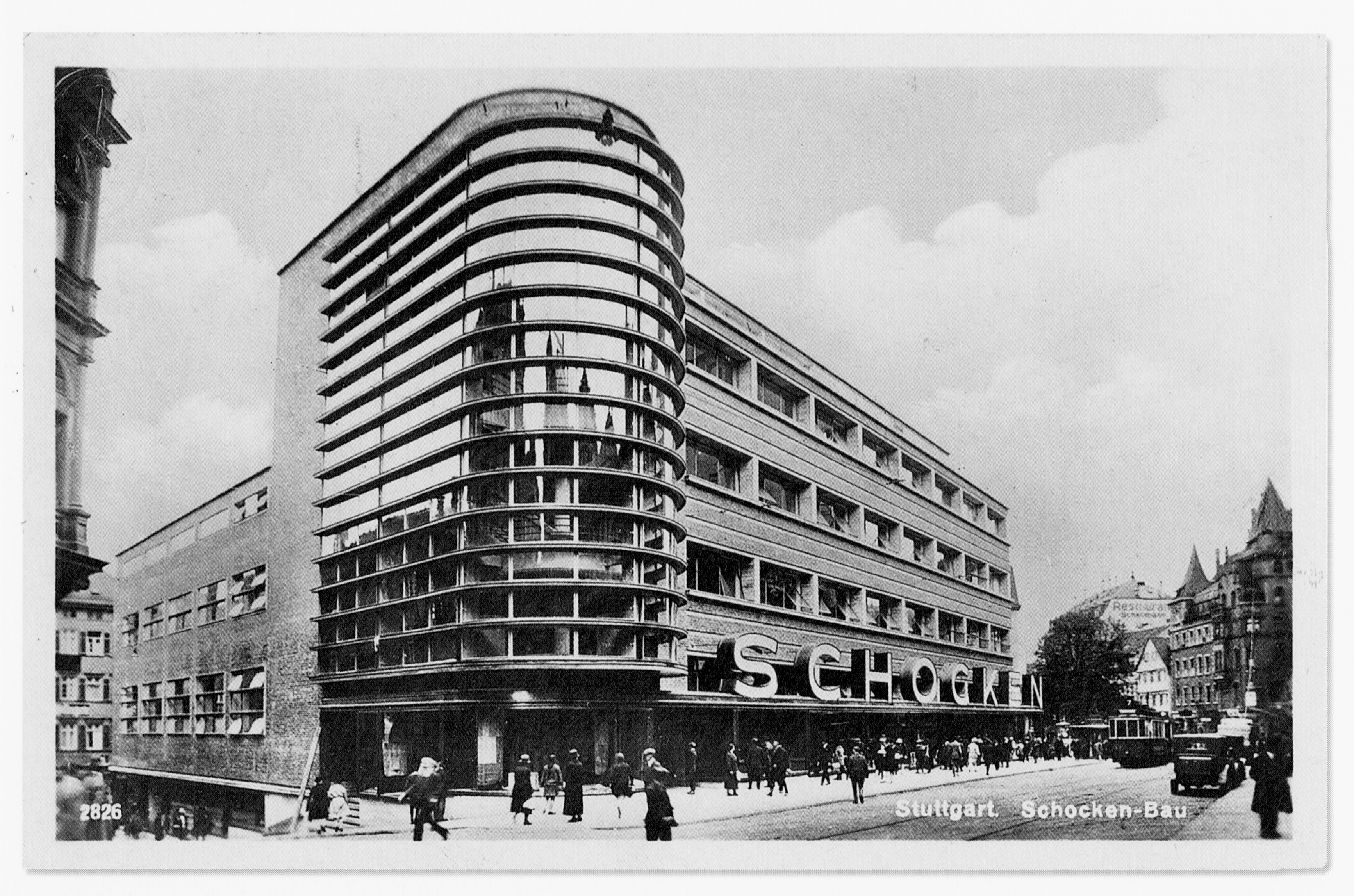 Postcard of Schocken department
store, 1920s to 1930s. Figure 10
Postcard of Schocken department
store, 1920s to 1930s. Figure 10 Postcard of Schocken department
store, 1920s to 1930s. Figure 11
Postcard of Schocken department
store, 1920s to 1930s. Figure 11 Postcard of Schocken department store, 1920s to 1930s. Figure 12
Postcard of Schocken department store, 1920s to 1930s. Figure 12 Postcard of Schocken department store, 1920s to 1930s.
Postcard of Schocken department store, 1920s to 1930s.
The reason modern architecture may nonetheless have preferred
the humble postcard as the medium for its dissemination
cannot be sought in any antagonism to cinema. One rather
banal circumstance is that by the late 1920s, and especially
after the coming of sound, fewer opportunities were left for
showing documentary or experimental films as part of
regular theater screenings. This led to a steep decline in the
production of avant-garde cinema generally, which had to retreat
to cine-clubs and specialized venues. Postcards, by contrast,
offered cheaper, quicker, and more widely accessible means of
publicizing the “New Vision” (Neues Sehen) of which the modern
movement in architecture, along with photography and
interior design, were such eloquent manifestations. Combining
mobility (of the object) with fixity (of the view), the architec-p. 89tural postcard became a theoretical construct as well as a
popular medium. Figure 13 Peter Behrens. AEG turbine factory, Berlin, 1908. As shown on the cover of the brochure AEG Flammeco-Lampen (1913).
Peter Behrens. AEG turbine factory, Berlin, 1908. As shown on the cover of the brochure AEG Flammeco-Lampen (1913).
Given architectural modernism’s interest in movement,
mobility of the gaze, and the human point of view, the modern
movement’s deployment of the postcard as the medium of
choice when offering a building to the beholder’s eye creates
further ambivalence between movement and stasis. Ambivalence,
rather than either rejection or embrace of the moving image.
To understand what is at stake, who better to consult than
Le Corbusier? On the one hand, he was the embodiment of the
plan, the grid, and the cube. On the other hand, he was the
advocate, if not the inventor, of the promenade architecturale.
As “the observer’s pathway through the built space,” the architectural
promenade named “the sequence of images that
unfolds before the eyes of the observer as he or she gradually
advances through the structure. It is the creation of a hierarchy
among the architectural events, a set of instructions for reading
the work.”27 The term is so often evoked because it seems to
effortlessly and self-evidently make the case for Le Corbusier’s
architecture (and, by implication, modern architecture generally)
as a proto-cinematic experience, a sequence of frames or
shots that each promeneur assembles into his or her own
film.28 But we may be dealing with two kinds of cinema; or
rather, two distinct visual dispositifs: a cinema for the eye,
organized around the cinematic apparatus; and a cinema of the
body, organized around the senses or, perhaps more accurately,
around the body as total perceptual surface.29 The architectural
postcard blends and blurs these two dispositifs, one focused on
the disembodied “eye,” the other on the embodied senses. The
postcard thus maintains both a normative position (its view is
classically “centered”) and a subversive position (it wanders,
circulates, is part of a relay) and thus breaks, in its reception, p. 90 with the strict alignment of the geometry of the cinematic
representation (the projecting cone) and the geometry of architectural
representation (the angled view), to which it owes
its production.
Yet, just as cinema did not always adhere to the rigid parameters
of Renaissance monocular perspective (e.g., “Early
Cinema,” the “cinema of attractions,” avant-garde practice in
the 1920s and 1970s) and knew several “cinemas of the body”
(e.g., “haptic cinema,” “the skin of film”), some architectural
representations also broke with the classical rules of isometric
and axonometric projections. Le Corbusier’s promenade architecturale
is a reminder of such an “architecture of the body”—a point he made explicit when he remarked,
Arab architecture teaches us a valuable lesson. It is best
appreciated on foot. Walking—you have to walk through
a building with a changing viewpoint to see the articulation
of the building deployed. It is the opposite to that
of Baroque architecture, which is conceived on paper
around the fixed vertical axis. I prefer the teaching of
Arab architecture.30
That the “Arab village” should turn up as an insult in the context
of rejecting the white-cube modernism of the Weissenhofsiedlung
is more than a little ironic.
In many respects, the architectural postcard is a subset of
the larger and much better-known field of “architecture and
photography,” a field that is as old as photography itself. After
all, the first photographs were of buildings: a picture of a shed
and a chestnut tree taken in 1826 and a picture of Notre Dame
taken in 1838 and greeted by the Paris critic Jules Janin with the
words, “Monsieur Daguerre ordered the towers of Notre Dame:
Become Picture.”31 By 1905, stereoviews of landmark buildings
were known to millions through the rotary viewing platform of
August Fuhrmann’s Kaiserpanorama or (in the home) through
the portable Holmes stereoscope.32Figure 14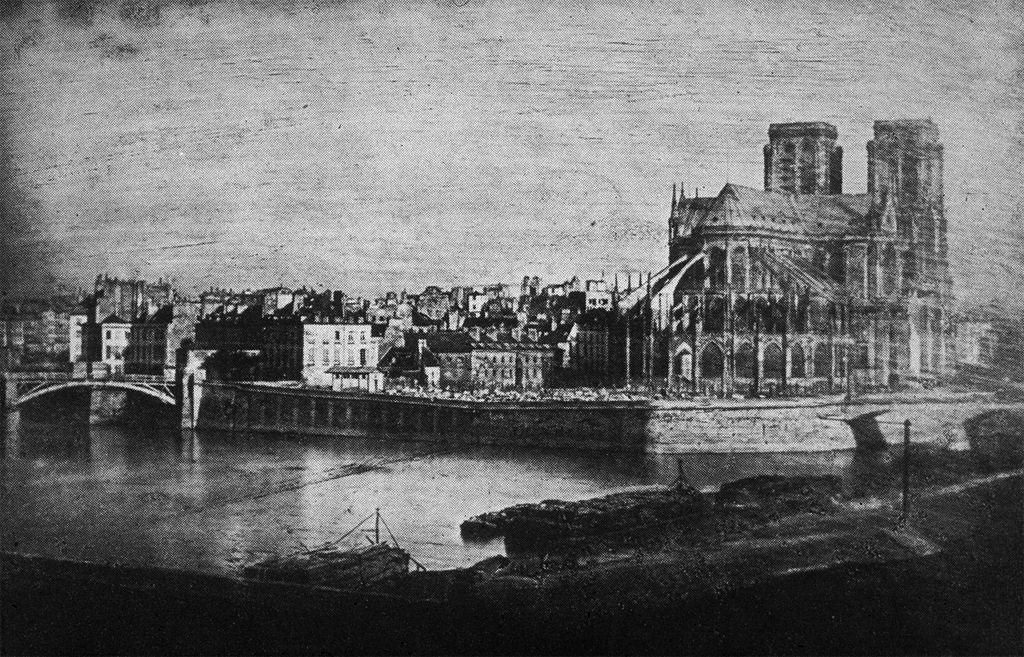 Louis-Jacques-Mandé Daguerre. Notre-Dame from the Pont des Tournelles, ca. 1838–1839.
Louis-Jacques-Mandé Daguerre. Notre-Dame from the Pont des Tournelles, ca. 1838–1839.
Yet, to my knowledge, among the many books devoted to
architecture and photography, none deals with the architectural
postcard.33 As a mass medium, it had a relatively short life
before becoming a hobby and a collectors’ item.34 Nevertheless,
the technological changes documented from the 1930s onward
allow one to surmise that one of the reasons for the disappearance
of the architectural postcard as a special genre is that
architects were presented with another solution for making
architecture mobile and circulatory while maintaining control
over perspective and point of view. A new dispositif arose for
modern architecture, one that superseded the postcard as
promotional tool: the glossy magazine, defined by its shiny
paper, high-quality photographs, and advertisements of luxury
consumer goods and fashion. This new medium offered even
wider dissemination and, perhaps just as important, a different
configuration of image into object and object into image, bringing
architecture ever closer to the commodity and to design, p. 91 by entering into the domestic space of consumption and display
while inserting itself into the space of fashion and news.
By the end of World War II, the architectural postcard had
been replaced by the architectural photograph as the medium
of choice for disseminating the International Style, thanks to
better and cheaper offset lithographic printing technology. But
no sooner was architecture’s new mass medium in place than
another ambivalence arose, for one of the consequences was
the emergence into prominence of the photographer, often
anonymous in the days of the postcard but now, on the pages of
the glossy magazine, a rival to the reputation of the architect.
Take the case of Julius Shulman, an American photographer,
who during the 1950s and 1960s worked closely with Frank
Lloyd Wright, Charles Eames and Ray Eames, and Richard
Neutra. Scholars still debate the extent to which the modern
movement in the United States owes its success to photographs
such as Shulman’s iconic shot of the Kaufmann House in Palm
Springs, designed by Neutra, and published in numerous
magazine spreads. Shulman’s authorship is even more in evidence in the so-called Case Study House #22, sometimes also
known as the Stahl House (named after its first owner) and
rarely mentioned under the name of its architect, Pierre Koenig.
As the Wikipedia entry diplomatically states,
The clarity of Shulman’s work demanded that architectural
photography had to be considered as an independent
art form. Each Shulman image unites perception and
understanding for the buildings and their place in the
landscape. The precise compositions reveal not just the
architectural ideas behind a building’s surface, but also
the visions and hopes of an entire age. A sense of humanity
is always present in his work, even when the human
figure is absent from the actual photographs.35
But behind this “sense of humanity” were fierce power struggles
and battles of egos, notably in the case of the Kaufmann
House. The eponymous client at one point tried to prevent the
pictures from being published, and Neutra was known to carry
with him a laminated photo of a Time magazine cover with his
own image on it so as to get preferential treatment on airplanes p. 92 or a better table at Los Angeles restaurants.36 As one of Neutra’s
biographers wrote,
Neutra incorporates so much of the ambivalence toward
architectural photography that is currently manifested in
the architectural community. His clear and elegantly
phrased intellectual grasp of the limitations of architectural
photography coexisted with a deep fascination with
the way in which his architecture and, indeed, he himself
were represented in photographic prints and the media.37
Figure 15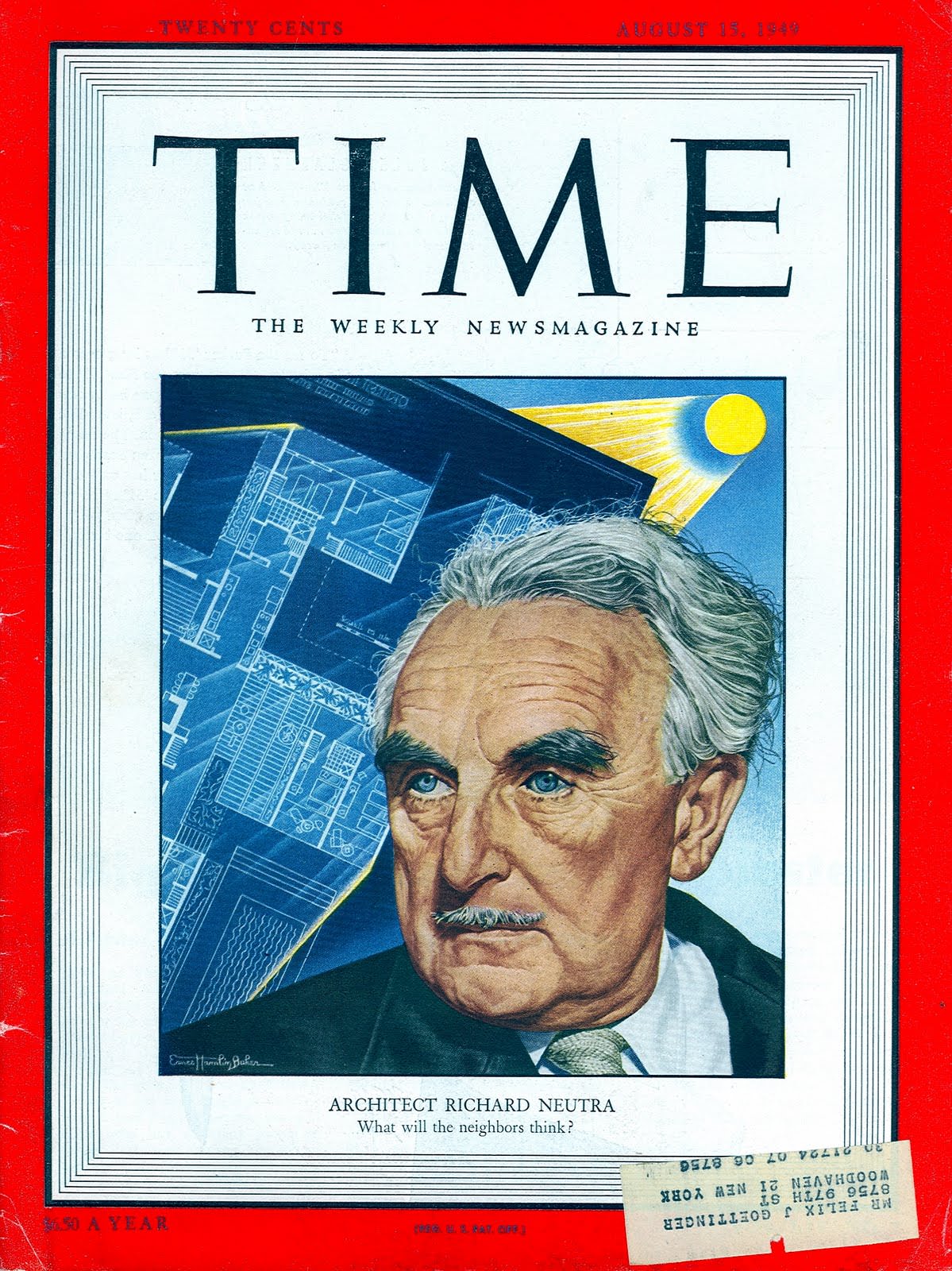 Richard Neutra on the cover of Time (15 August 1949).Figure 16
Richard Neutra on the cover of Time (15 August 1949).Figure 16 “Glamourized Houses,” Life (11 April 1949), featuring photographs by Julius Shulman. Top: Richard Neutra. Kaufmann House, Palm Springs, 1946.
“Glamourized Houses,” Life (11 April 1949), featuring photographs by Julius Shulman. Top: Richard Neutra. Kaufmann House, Palm Springs, 1946.
Neutra’s ambivalence was not just a personal quirk arising
from rivalry over authorship and attribution. The glossy magazine
as mass medium determines much of the context within
which architectural photography acquires its special status of
exclusivity and style and, consequently, what kinds of meaning
can be ascribed or attributed to a building’s appearance and
layout on the page. No longer the diva ready for her close-up, it is now more the setting of beautiful people and beautiful objects,
as magazine spreads of architecture tend to either include human
beings or make their (temporary) absence more keenly felt. At
the same time, each modern building thus featured invariably
serves to advertise the group sensibility of the modern movement,
with the magazine confirming the style as a brand and
the brand endorsing the magazine. The magazine photograph
takes the process of object merging into image and image
merging into fetish one step further by embedding the transformation
even more firmly in the circulation of commodities
as images and images as commodities.38
A somewhat different, if equally instructive, transubstantiation
has taken place in the case of the Frankfurt Kitchen, the
first functioning built-in or fitted kitchen, designed by Grete
Schütte-Lihotzky for Ernst May’s housing developments in
Frankfurt-Römerstadt and Ginnheim-Höhenblick. Some 15,000
units were built from 1928 to 1930 as part of an effort to provide
affordable housing, the so-called “Living-Space for those
on an Existential Minimum income.”39 The Frankfurt Kitchen p. 93 is best known thanks to a photograph, taken by an unidentified
photographer, that has been reproduced a hundred times in
architectural histories, textbooks, exhibition catalogues, and,
of course, Wikipedia. My interest in the kitchen was stirred by
the fact that, in addition to the photograph, there is a film, until
recently little known and even less studied.40 What I found in
my research, however, was that the Frankfurt Kitchen was a
mixed blessing for those living in the housing units. The inhabitants
did not think of kitchens as machines for cooking but as
the center of family life. For this, Schütte-Lihotzky’s design was
not only too small but completely unsuitable. (Many occupants
ripped out the kitchen or used it as a storage space.)41 The
Frankfurt Kitchen thus owes much of its enduring fame to a
photograph rather than to its functionality.42 However, since
the late 1980s (and no doubt connected with the rise of installation
art), just about every major museum has sought to acquire
a Frankfurt Kitchen for its collection. The Minneapolis Institute
of Arts has one, as does the Museum für angewandte Kunst in
Vienna (Schütte-Lihotzky’s hometown), the Victoria and Albert
Museum in London, and the Museum of Modern Art (MoMA)
in New York, which prominently displayed the kitchen at its
2010 Counter Space exhibition.43 Some of the kitchens are “original,”
some are reconstructions, and all are three-dimensional.
Invariably, however, they are also reproduced in print in exactly
the 2-D position made iconic through the historic photograph
first printed in Das neue Frankfurt.44 Thus, this built(-in) architectural
space became a photograph, and over time that photograph
took on a reality of its own—so much so that at another
point in time the photograph, in order to index its referent
“authentically,” once more became (ex)posed space. That is, a
nonfunctioning functionalist object became an image only for
the image to become an installation.45Figure 17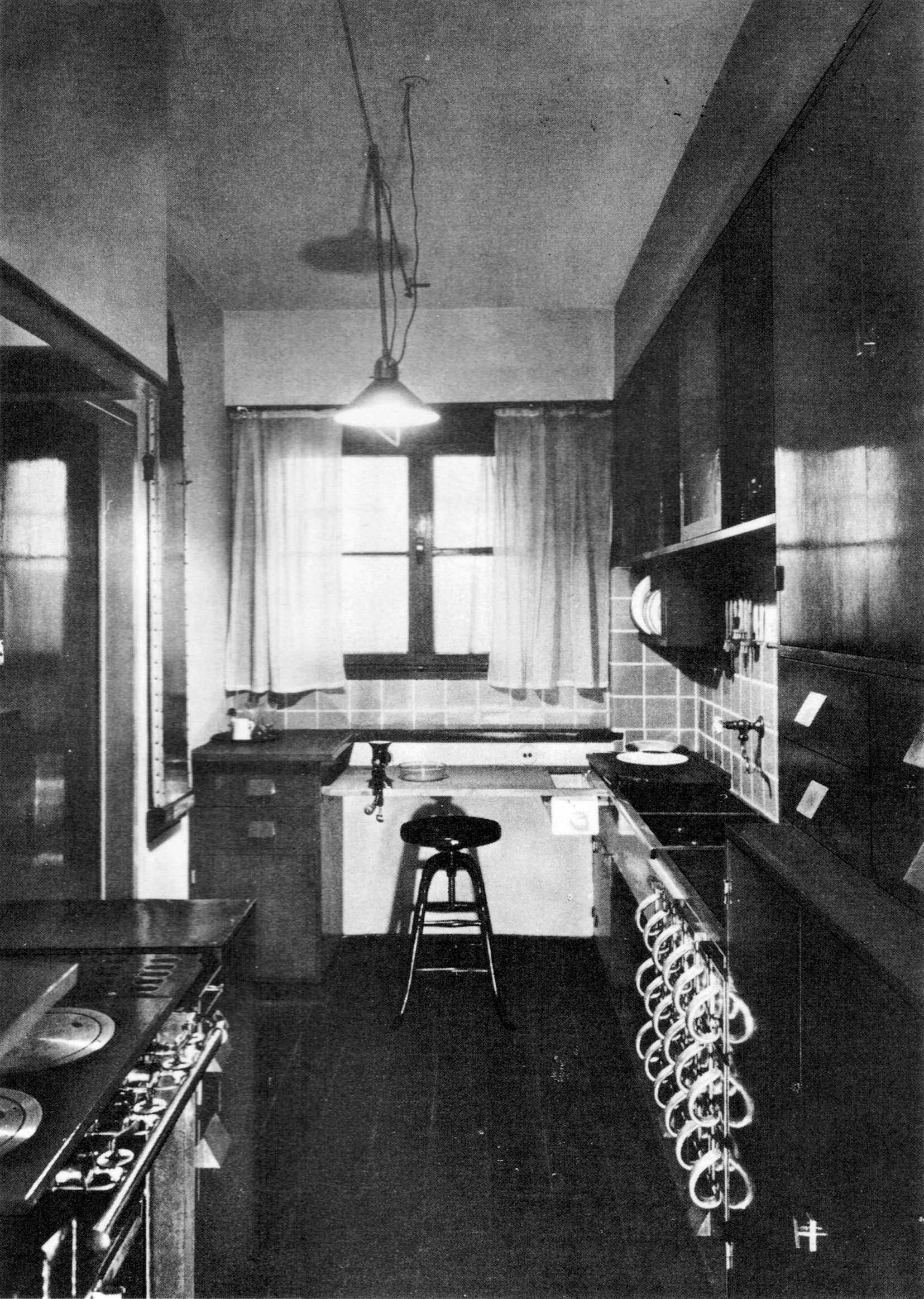 Grete Schütte-Lihotzky. Frankfurt Kitchen, 1926–1927. Photograph from Das neue Frankfurt (1927).Figure 18
Grete Schütte-Lihotzky. Frankfurt Kitchen, 1926–1927. Photograph from Das neue Frankfurt (1927).Figure 18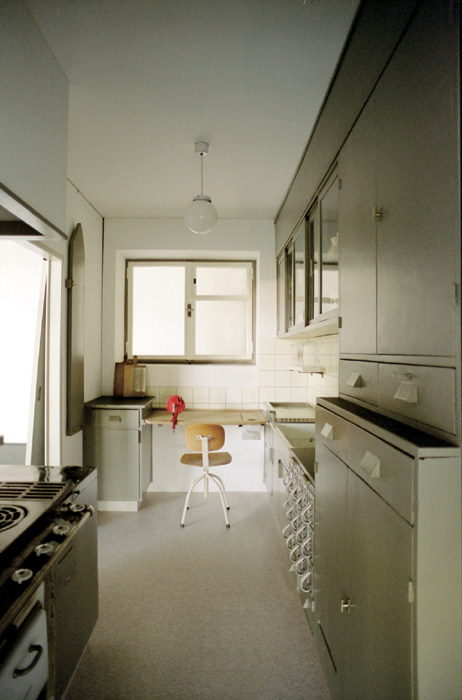 Reconstruction of Schütte-Lihotzky’s Frankfurt Kitchen, Museum of Modern Art, New York.
Reconstruction of Schütte-Lihotzky’s Frankfurt Kitchen, Museum of Modern Art, New York.
A further reason architectural photographs are so attractive
but also so problematic as representation is the way the photographers
are able to manipulate size, scale, and the impression
of depth. In an insightful essay, Claire Zimmermann
highlights the reciprocal but strategic relationship:
Architects need photography, not only to publicize their
work but also to produce the visual evidence that lets them
maintain themselves as architects on a world stage. . . . More than ever, the camera (and increasingly the computer,
producing the digital model of the project that prefigures
the photographs of the building to come) is a critical
collaborator in the ongoing formation of architecture as a
media-sensitive enterprise. And the discrepancies between
photographic image and construction on the ground are
now a presumptive condition of both practices.46
Zimmerman then documents how photographers from the
1920s onward played with scale in their compositions, used
special lenses, and varied the physical point of view in order to
convey the soaring power of skyscrapers and give added depth p. 94 to domestic interiors.47
Crucial in this development, besides German precision optics,
were some of the avant-garde practices of Weimar Germany’s
photographers of the Neue Sachlichkeit, which Zimmerman
typifies with three terms: “exaggeration, suppression, ambiguity.”48 These practices contrast intriguingly with some of the
better-known principles of the “new objectivity,” such as functionality,
sobriety, and formal minimalism, which may explain
why these photographic methods often transferred quite seamlessly
to the needs of the new regime after 1933. Wanting to
show off their megastructures to optimum effect by playing on
size and scale, Nazi architects, planners, and engineers
retained many of the functionalist principles in industrial
buildings and technical norms and designs.49 By showing only
parts of a building and judiciously choosing the surroundings or eliminating context, effects of overpowering grandeur can be
achieved, as in Ezra Stoller’s Dulles Airport Terminal photographs
from 1964, but already practiced by Le Corbusier
in 1920.50
The three ways in which, according to Zimmerman, architectural
photography plays with our perception of scale are still
with us today, albeit now manifesting themselves in a different
medium—computer-aided design—that allows for an even
broader spectrum of special effects by which to affect our sensation
of presence and our experience of space: pulling us in
by putting us at the apex of the visual cone while simultaneously
overwhelming us. One conclusion to draw, then, is that
the two visual dispositifs—the classic cinematic apparatus in
it geometrical rigidity and optical fixity; and the promenade
architecturale, with its ambulatory fluidity and peripatetic
assemblage—are, thanks to cinema’s general relocation, no
longer separate or opposed. A new ubiquity of cinema is p. 95 evident on mobile screens, distributed in public, domestic, and
art spaces, projecting or emitting images animated by the
enhanced simulation techniques of digital software.
Among the phenomena that can be observed, I single out
what I consider to be yet another reversal of the two-way
transfer from object to image to object that characterizes the
Frankfurt Kitchen and its photograph. In the case of this reversal,
buildings are conceived with the image they want to produce
of themselves already in mind. They are thus as much built to
be seen with the photographer’s eye as they are built to be used
or inhabited, since the manipulations of scale and size entered
into their construction at the drawing stage.
Consider the cinema building in Amsterdam that went up in
2000 in one of that city’s typical streets of steep, narrow houses.
A multiplex with thirteen screens, it had to squeeze into a corner plot, extending in depth and height to fill the space of
the respective back-houses, while having only a small part of
the street frontage as its entrance. Designed by Georges van
Delft and the French architect Christian de Portzamparc, the
Pathé De Munt manages to do by itself and in real space what
the architectural postcard used to do; namely, distort scale and
exaggerate perspectival sight lines for added effect. A brutalist
trompe l’oeil, the façade is slanted and angled (the return of the
“relief”) so as to simulate a depth that is pure perspectival illusion.51 Best seen as one approaches it from across the street, the
Pathé De Munt monumentalizes in brick and stone one’s anticipation
of the Hollywood blockbuster about to be screened
inside. But it also acknowledges the fact that our perceptual
field is one in motion, and it has adjusted itself to photography’s
way of seeing built space and the environment, now that
the modern movement’s “new vision” has become the default
value of human perception. Figure 19 Christian de Portzamparc. Pathé De Munt, Amsterdam, 2000.
Christian de Portzamparc. Pathé De Munt, Amsterdam, 2000.
p. 96
This is brought home most strikingly when one compares
Portzamparc’s façade with Amsterdam’s other landmark cinema,
the Pathé Tuschinski, no more than two hundred yards
around the corner from the Pathé De Munt. A “spectacular mix
of styles, as designed by Hijman Louis de Jong; Amsterdam
School, Art Nouveau and Art Deco,” the Tuschinski has a magnificent
façade.52 As that word implies, you need to face it
frontally, get close, then crane your neck, step back, or otherwise
displace yourself mentally and emotionally to take in its
scale and detail, each requiring a different point of view and
another way of seeing. Figure 20 Hijman Louis de Jong. Pathé Tuschinski, Amsterdam, 1921.
Hijman Louis de Jong. Pathé Tuschinski, Amsterdam, 1921.
While preparing the illustrations for this article, many of the
photographs I looked at online were found on Flickr, Instagram,
and other photography websites to which users had uploaded
their own photographs of architectural landmarks. I realized
that—from the point of view of circulation and dissemination
at least—these and other user-generated content sites may well
be the heirs to the architectural postcard. Add the sort of software—from Adobe Photoshop to Microsoft Photosynth—that
allows users to fashion three-dimensional renderings out of
their own and other people’s holiday snaps of famous sites, and
yet another popular mass medium for architecture is surely in
the making.









































